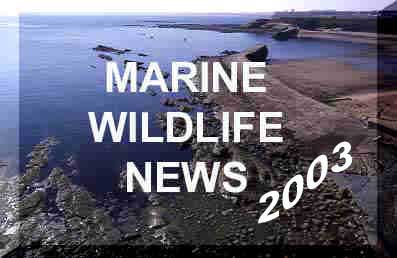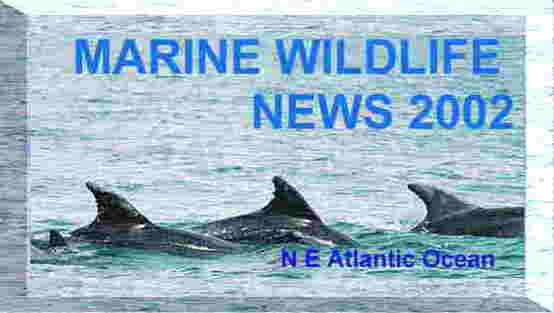
|
|
|
|
|
(BMLSS *** Site) |
|
|
|
Norwegian Marine*** |
|
L-I-N-K-S to Other Sites (Click on Text) |
|
Smart Group |
 |
|
|
|
|
|
|
 .
.
Reports of marine wildlife from all around the British Isles, with pollution incidents and conservation initiatives as they affect the fauna and flora of the NE Atlantic Ocean.
on Microsoft Internet Explorer (best) or Netscape
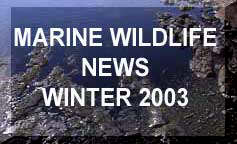 |
 |
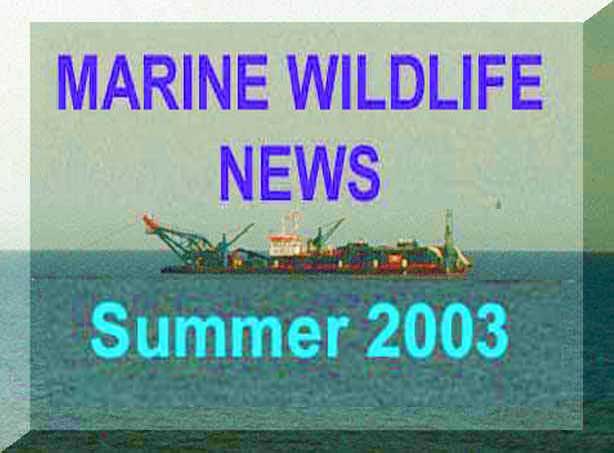 |
 |
LATEST WILDLIFE NEWS: AUTUMN 2003
- 30
December 2003
Approximately 500 - 750 Common Dolphins, Delphinus delphis, were seen in Falmouth Bay, Cornwall, between 11.30 am & 12.00 pm, heading towards the Lizard. The dolphins were seen made from the Orca-Seafaris boat by Keith Leeves, Suzi Gilpin, Caroline Curtis, Gary Hawkins, Dan, Phil & Dave Jarvis & others.
28
December 2003
A
rorqual
whale of over 30 tonnes is washed up dead
on the sandy shore of the bay of Audierne, between Tronoën and the
Torch, near Plomeur near Quimper, southern Brittany, France. Samples have
been taken by Oceanopolis, Brest (Public
Aquarium) who identified the species as a Fin
Whale, Balaenoptera
physalis, that had recently died and measured 19.5 metres
in length.
Full
Report
19
December 2003
A
"superpod"
of thousands of dolphins was spread over
about two and a half miles off Nare Head, on the Roseland Peninsula, Cornwall.
The species involved is the Common Dolphin,
Delphinus
delphis, of all age groups including calves and mothers. Other small
cetacean species were possibly present. These superpods are a rare once
in a lifetime event around the British coast, but very large pods have
been seen off the Cornish coast in recent years, the previous
one occurring at the beginning of the year. The superpod was accompanied
by sea birds including Gannets
feeding on Mackerel, and Guillemots.
Large Pods of Dolphins off Cornwall in January 2003 (1)
Large Pods of Dolphins off Cornwall in January 2003 (2)
BMLSS Cetacea
18
December 2003
Two Humpback
Whales, Megaptera
novaengliae, were seen near The Hague (Den Haag), Zuid-Holland.
They were discovered by the local department of the lifeboat association
who prevented the whales from swimming towards the coast. At dusk they
lost the animals near ´s-Gravenzande, some 10 kilometres south of
The Hague. The animals were estimated to be 8 and 18 metres long. They
were not seen by any of the local sea-migration watchers; the Humpbacks
were identified by the pictures made by one of the members of the lifeboat.
The identification was confirmed by Kees Camphuysen.
This
is the first record of living Humpbacks for the Netherlands.
Full
Report on UK Cetnet
Photograph
Report (in Dutch) with links to Photographs
Barnacles on Whales (notes)
Barnacles (notes)
BMLSS Cetacea
BMLSS Barnacles
5 December
2003
A
medium-sized Bluefin Tuna, Thunnus
thynnus, was landed at Plymouth Fish Market. It was caught about 24
nautical miles east of Lizard Point, SW Cornwall in a mid-water pair trawl.
Adult Bluefin Tuna are no longer caught regularly caught off England and
the last one on record was caught in 1968.
BMLSS Tunnies
4 December
2003
Walkers
along the coast at Bovisand in Devon were treated to a rare sight as a
five metre long whale was temporarily stranded close to the shore in Heybrook
Bay (next to Wembury Bay, east of Plymouth). It has been identified as
a Northern Bottle-nosed
Whale, Hyperoodon ampullatus, after
originally being identified as a Pilot Whale.
The malnourished whale
was spotted by a walker, Steve Blackhouse,
who quickly rang the Coastguard.
Bottlenose
Whales are rarely seen in the English Channel,
normally preferring in waters up to 1,000 metres deep, off the continental
shelf.
"Western
Morning News" Report
Marine
Mammals of the UK Smart Group
British
Marine Life Rescue Report
BMLSS
Cetacea
31
November 2003
A
Cornish long-line fishermen has caught a total 115
Porbeagle
Sharks, Lamna
nasus, on two long-line fishery trips to
their feeding grounds off Cornwall. The largest one weighed 60 kg (132
lb), but is unclear if this was the weight before on after it was gutted.
It was two metres long, probably including the tail fin. These look like
a pre breeding stock of Porbeagles with females that do not attain maturity
until they are two metres in length. This mass capture has raised the ire
of environmentalists as the large species of sharks and even some of smaller
species like the Angel Shark, Squatina
squatina, are vulnerable to excessive
fishing. In the 1960s the Newfoundland fishery for Porbeagle was seriously
overfished as ceased as a commercial activity. Hundreds of Porbeagle Sharks
are caught off northern France each year.
BBC
News Report
BMLSS
Sharks
23
November 2003
A
pod of five Risso’s
Dolphins, Grampus griseus, including
two large adults, one with a distinctive notch in its dorsal fin, were
spotted from dry land off Stumble Head, Pembrokeshire.
(Sea Trust S&W Wales) via UK Cetnet
BMLSS Cetacea
19
November 2003
The
serpullid worm Ficopomatus enigmaticus
has been discovered in Brooklands Boating Lake,
east Worthing, Sussex, for the first time. The tubeworms now seem to have
died, but this low salinity brackish water lake may increased in salinity
because of the lack of rainfall this year and provided a temporary niche
for large colonies of these worms.
This
is an abundant species.
Images
via the Marine Wildlife of the North-east Atlantic Ocean Group
Our
Dutch name translates into: "trumpet-calcareous-tube-worm" since the tube
often looks as a series of trumpets. This worm disappears after cold winters,
demonstrating its subtropical origin.
JNCC Information Page on Ficopomatus enigmaticus
16
November 2003
At
a depth of nine metres on the muddy bottom of Loch Creran, Scotland, the
nudibranch
Facelina
bostoniensis appears to be feeding on the Slender
Sea-pen,
Virgularia
mirabilis, which is not noted as a food source for this species
in British text books, although it is known to feed on a variety of hydroids.
Sea Slug Forum Discussion & ID
Opisthobranch Newsletter (Trondjhem Biological Station, Norway)
28
October 2003
The
unusual nudibranch feeding on a sea
anemone on the lower shore at La Valette on Guernsey's east coast has
been identified as probably being the species Aeolidiella
alderi.
However,
there is still some doubt over the identification and readers are recommended
to have a look at the photograph on the web
site below.
Sea Slug Forum
Sea Slug Forum Messages
Sea Slug Forum Species Index
Bernard Picton's Nudibranch Site
BMLSS Nudibranchs
24-25
October 2003
A
large number of Sea
Hares, Aplysia
punctata, are
discovered at
Pendennis Point, Falmouth, Cornwall. They were mating and in about six
metres of water.
 Thousands
(literally) of Sea Hares
were seen at Porthcothan, Cornwall, on the rocks around Arch Rock at a
low spring tide. Their sizes varied from very small
up to 50 mm long. This is unusual as shore migrations of adults usually
occur in spring.
Thousands
(literally) of Sea Hares
were seen at Porthcothan, Cornwall, on the rocks around Arch Rock at a
low spring tide. Their sizes varied from very small
up to 50 mm long. This is unusual as shore migrations of adults usually
occur in spring.
Shorewatch Biological Recording
BMLSS Molluscs
20
October 2003
A
seal
caused
a bit of flutter when it was spotted a long way up the tidal River Thames,
swimming eastwards towards the sea between Waterloo Bridge and Blackfriars
Bridge in a busy part of the city of London. This is less than a mile from
the House of Parliament, Westminster.
11
October 2003
The
SHOREHAM FISH FESTIVAL on Coronation
Green, Shoreham-by-Sea,
West Sussex, was attended by 4,000 people if the sunshine as the high six
metre spring tide filled the river just before 1:00
pm. The British Marine
Life Study Society held an aquarium display
and despite technical problems with a very high plankton content in the
water (which meant the large wrasse could not
be displayed) the exhibits were well received by the younger age group.
Picture
Gallery
8 October
2003
The
ascidian Perophora
japonica was collected from crab pot rope off the south coast
of Guernsey by Clive Brown.
Colonies of this sea squirt live on fucoid seaweeds, pontoons and other
hard substrates. The small translucent zooids (approximately 4 mm long)
are budded from stolons and generally rather closely packed. Young parts
of colony are yellow or greenish-yellow.
This
ascidian was first recorded in the British Isles in Plymouth Sound in 1999.
It had been discovered on the French coast of Brittany a few years earlier.
There has also been a further discovery in the Fleet Lagoon, Dorset (near
Chesil Beach).
Report
Message
Further
Information (Marlin)
on the Marine Wildlife of the North-east Atlantic Ocean Group
7
October 2003
A Humpback
Whale,
Megaptera novaengliae, off
the Netherlands, was found dead at Maasvlakte, Rotterdam, Zuid--Holland.
This was the same one that was seen floating on 29
September 2003, a young female, 9 metres in
length.
3 October
2003
Fifteen
Risso’s Dolphins, Grampus griseus,
were observed at Runnelstone off the Cornish coast, seven large ones keeping
apart from each other and a pod of five with some juveniles were milling
about in an area of fishermen's pot markers. Later, they all headed slowly
westward.
1
October 2003

Photograph by Norman D. van Swelm
The young eight months old Humpback Whale, Megaptera novaengliae, was washed ashore dead on the coast of Katwijk, with the tail and a part of the right flipper missing, with some thin ropes, blue and red/orange in the wounds.
29
September 2003
A
large dead whale, initially identified as a Minke
Whale, Balaenoptera acutorostrata,
was reported floating 8 km west of Hoek van Holland. Subsequently, it was
decided to tow the whale out of the way. However, after an analysis of
several photographs by Kees Camphuysen,
the whale was identified as a Humpback
Whale, Megaptera novaengliae. This
the first record of this species in The Netherlands!
Three
Images
27
September 2003
An
outlandish and completely unexpected addition to the Portland Island (Dorset)
mammal list came today in the form of a Harp
Seal,
Pagophilus groenlandicus,
that was found hauled out on rocks along the East Cliffs at the Bill during
the afternoon; it remained there for three hours before being flushed off
by the incoming tide.
Photograph
The
Harp Seal is an Arctic species that is hunted (cf. culled) in the frozen
north of Canada.
ORCA (Organisation Cetacea) Report with previous sightings
BMLSS Seals
20
September 2003
A
Swordfish has been reported stranded on
the Causeway to Worms Head, near Rhossilhi Beach, Gower peninsular in south
Wales. It lived for one hour.
NB:
this report has not been confirmed.
The
swordfish very occasionally reported in British seas is the Broad-billed
Swordfish,
Xiphias gladius.
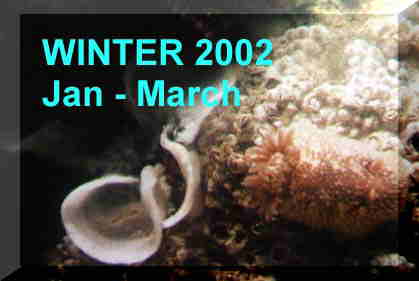 |
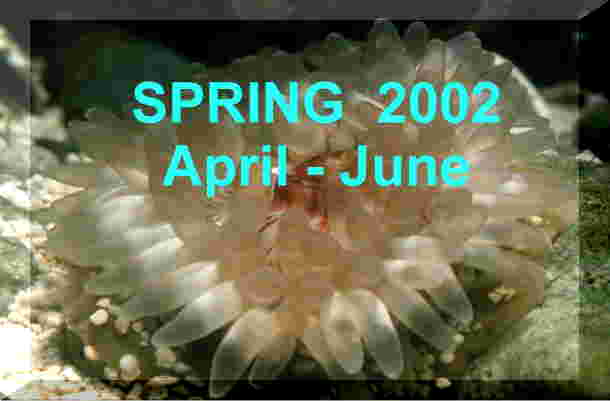 |
 |
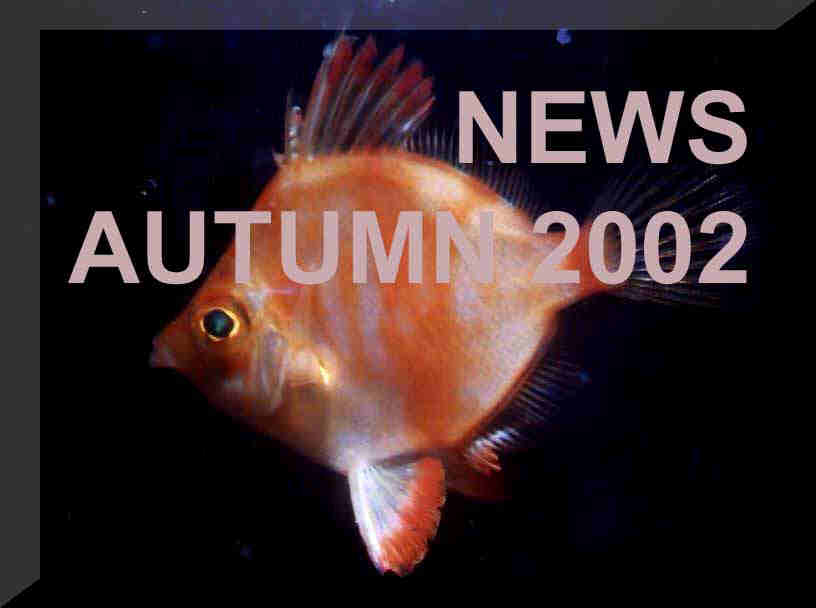 |
FOR EARLIER REPORTS CLICK ON THE BUTTON BELOW

The Marine Wildlife of the NE Atlantic Forum commences.
PLEASE JOIN

MARINE WILDLIFE of the NE ATLANTIC EFORUM PAGE (LINK TO)
News 2002
News 2001
News 2000
News 1999
|
Use these links if your are familiar with the scientific classifications of marine life |
The BMLSS (England) site commenced on 1 January 1997.
|
|
 |
 |
Andy Horton, Webmaster
|
|
|
|
|
|
Membership Form |
News 2001 News 2010 |
